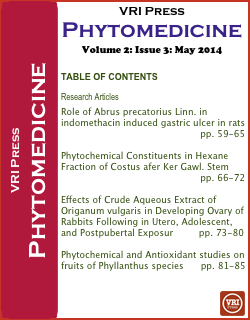
Effects of Crude Aqueous Extract of Origanum vulgaris in Developing Ovary of Rabbits Following in Utero, Adolescent, and Postpubertal Exposure
Abstract
We evaluated the impact on rabbits after having been treated with Origanum vulgaris (Lamiaceae) (OV) at a dose level known to adversely affect ovarian functions in rodents without causing systemic toxicity. The choice of rabbits has been guided by the fact that rabbits have a relatively long phase of reproductive development and hence simulation of reproductive development is better as opposed to dealing with rodents. The use of rabbits facilitates multiple evaluations of mating ability. An attempt has also been made at determining whether OV affected ovarian development and hence the use of animal model. Rabbits were exposed to 80 mg OV/kg/day in utero (gestation days [GD] 0 to23) or during adolescence (postnatal weeks [PNW] 4 by breast feeding and orally from 4w to 12 w), and the offspring were examined at the end of the 12 W period. Another group was treated after puberty (for 12 weeks) till age of 24 [PNW] of age and examined at the conclusion of exposure and follicles were categorized as primordial, primary, small preantral, large preantral or small antral follicles. The most pronounced reproductive effects were in female rabbits group which had been exposed from in utero till post-puberty period, in weights of ovaries (at 12 and 24 weeks, down 23%; p < 0.05). Serum Gonadotropin levels were down (at 24 weeks, 32%; p < 0.05); a slight increase in histological alterations of the ovaries (p < 0.05) at 24 weeks, of abnormal follicles;Â
Keywords
References
Gondos B, Conner LA: Ultrastructure of developing germ cells in the fetal rabbit testis. Am. J. Anat., 1973 (136) 23–42.
http://dx.doi.org/10.1002/aja.1001360104
Gilani AH, Rahman AU: Trends in ethnopharmocology. J. Ethnopharmacol., 2005 (100) 43–49.
http://dx.doi.org/10.1016/j.jep.2005.06.001
Williamson EM: Synergy and other interactions in phytomedicines. Phytomedicine, 2001 (8) 401–409.
http://dx.doi.org/10.1078/0944-7113-00060
Baquar SR: Medicinal and Poisonous Plants of Pakistan. Karachi: Printas, 1989.
Srihari T, Sengottuvelan M, Nalini N: Dose-dependent effect of oregano (Origanum vulgare L.) on lipid peroxidation and antioxidant status in 1,2-dimethylhydrazine-induced rat colon carcinogenesis. J. Pharm. Pharmacol. 2008 (60) 787–794.
http://dx.doi.org/10.1211/jpp.60.6.0015
Duke JA: Handbook of medicinal herbs. Boca Raton, LA: CRC Press, 2002.
http://dx.doi.org/10.1201/9781420040463
National Research Council: Guide for the care and use of laboratory animals. Washington, DC: National Academy Press, 1996.
.Williamson EM, Okpako DT, Evans FJ: Pharmacological methods in phytotherapy research: Selection, Preparation and Pharmacological Evaluation of Plant Material volume 1. Chichester: John Wiley & Sons, 1996.
DiZerega GS, Ross GT: Clinical relevance of fetal gonadal structure and function. Clin. Obstet. Gynecol., 1980 (23) 849-861.
http://dx.doi.org/10.1097/00003081-198023030-00014
Matsuura H, Chiji H, Asakawa C, Amano M, Yoshihara T, Mizutani J: DPPH radical scavengers from dried leaves of oregano (Origanum vulgare). Biosci. Biotechnol. Biochem., 2003 (67) 2311–2316.
http://dx.doi.org/10.1271/bbb.67.2311
Djehiche B, Segalen J, Chambon Y: Ultrastructure of mullerian and wolffian ducts of fetal rabbit in vivo and in organ culture. Tissue Cell 1994 (26) 323-332.
http://dx.doi.org/10.1016/0040-8166(94)90018-3
Edeoga HO, Okwu DE, Mbaebie BO: Phytochemical constituents of some Nigerian medicinal plants. Afr. J. Biotechnol., 2005 (4) 685–688.
http://dx.doi.org/10.5897/AJB2005.000-3127
Lemhadri A, Zeggwagh NA, Maghrani M, Jouad H, Eddouks M: Anti-hyperglycaemic activity of the aqueous extract of Origanum vulgare growing wild in Tafilalet region. J. Ethnopharmacol., 2004 (92) 251–256.
http://dx.doi.org/10.1016/j.jep.2004.02.026
Lin SP, Tsai SY, Lin,YL, Kuo SC, Hou YC, Chao PD: Biotransformation and pharmacokinetics of 4-(3,4-dihydroxybenzoyloxymethyl)phenyl-O-beta-D- glucopyranoside, an antioxidant isolated from Origanum vulgare. J. Agric. Food Chem., 2008 (56) 2852–2856.
http://dx.doi.org/10.1021/jf703730e
Ocana-Fuentes A, Arranz-Gutierrez E, Senorans FJ, Reglero G: Supercritical fluid extraction of oregano (Origanum vulgare) essentials oils: anti-inflammatory properties based on cytokine response on THP-1 macrophages. Food Chem. Toxicol. .2010 (48) 1568–1575.
http://dx.doi.org/10.1016/j.fct.2010.03.026
Gondos, B, Conner LA: Ultrastructure of developing germ cells in the fetal rabbit testis. Am. J. Anat. 1973 (136) 23–42.
http://dx.doi.org/10.1002/aja.1001360104
Gondos B, Renston RH, Conner LA: Ultrastructure of germ cells and Sertoli cells in the postnatal rabbit testis. Am. J. Anat., 1973 (136) 427–439.
http://dx.doi.org/10.1002/aja.1001360404
Gondos B, Renston RH, Goldstein DA: Postnatal differentiation of Leydig cells in the rabbit testis. Am. J. Anat. 1976 (145) 167–181.
http://dx.doi.org/10.1002/aja.1001450203
Stuckhardt JL, Poppe SM: Fresh visceral examination of rat and rabbit fetuses used in teratogenicity testing. Teratog. Carcinog. Mutagen, 1984 (4) 181-188.
http://dx.doi.org/10.1002/tcm.1770040203
Gray TJ, Rowland I R, Foster PM, Gangolli SD: Species differences in the testicular toxicity of phthalate esters. Toxicol. Lett.1982 (11) 141–147.
http://dx.doi.org/10.1016/0378-4274(82)90119-9
DOI: http://dx.doi.org/10.14259%2Fpm.v2i3.142
Refbacks
- There are currently no refbacks.






